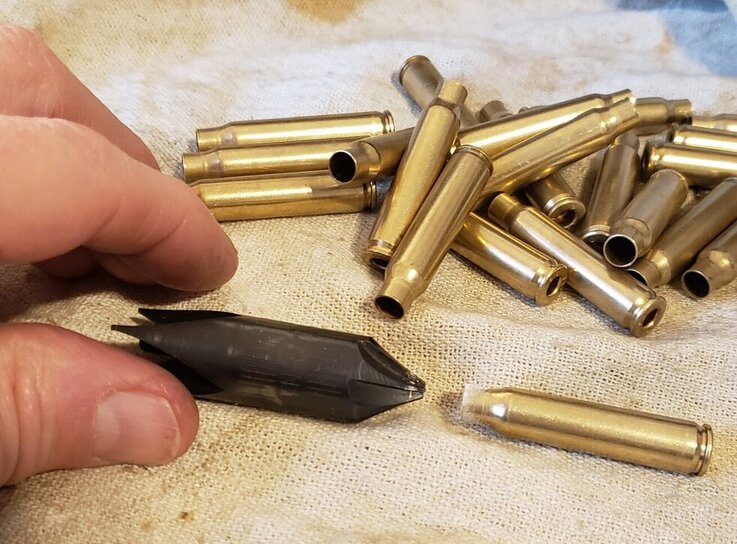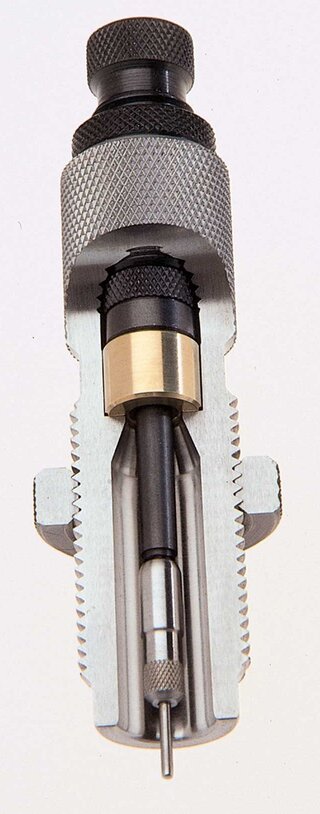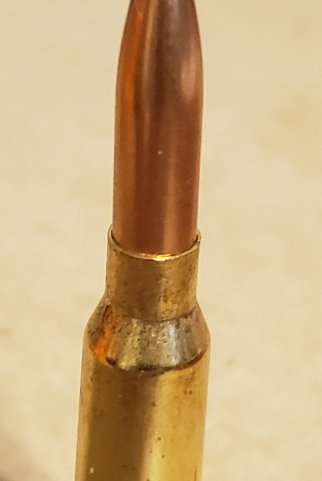Copyright 2021 – Stephen Redgwell
This article is about using a case neck expanding die with jacketed bullets.
Cast bullet users know the difficulties of seating lead bullets. Lead can shave off when the heel of the bullet contacts the edge of the case neck. Flaring dies were created that open up the neck just enough to allow the heel of the bullet to enter. It was a great idea, and one that can be used with jacketed bullet too!

Have you ever had a flat base bullet that was harder to seat because you had to force the heel into the case mouth? That puts extra pressure on the seating stem. It damages the hollow tip, and shortens its life. The stem will deform applying too much muscle on the press handle.

Bullets that are difficult to seat usually have ring marks near the tip, left by the seating stem (see picture above). The edge of the seating stem is impressed onto the bullet jacket. You do not want to deform the bullet jacket. This is one of the reasons competitive shooters are careful about how much they resize the necks.
The trouble often starts when you size the case. After it is fully raised into a conventional sizing die, the case mouth diameter is reduced several thou under the finished size. When you lower the ram, the expander ball pulls through the neck stretching it out to the finished diameter. That finished diameter may not be large enough.
You want the case mouth to measure about two thousandths of an inch undersize. For example, a 0.222 inch diameter for a 0.224 inch bullet. That’s enough to firmly hold the bullet in place, without reducing the case mouth diameter too much.
Do they actually sell sizing dies that don’t work properly? No, dies work, but they are compromises. Sizing dies will usually restore cases to their unfired dimension, but sometimes they don’t. There are fixes however.

The first is by chamfering (beveling) the case neck. That is usually enough to allow the bullet heel to ease into the case, but not always. What if the case mouth is still too tight? It could be that brand of case, or t could be the number of times the case was reloaded. The case necks can thicken. It’s what most reloaders refer to as brass flow. The brass moves toward the case neck with successive firings. Or it could be your sizing die.
This article will not address turning the case necks to shave off excess brass. Are there other alternatives?
You can buy a collet die. Collet dies can be adjusted a few thou to vary the case neck diameter. In other words, you can neck size a little or a few thou more. It’s an option that might help. Collet dies neck size only, so they are not the best for pump or autoloading rifles. As well, if you have a cartridge that is older, or improved, you will have to special order one from Lee.

You can also use a Redding Type S bushing die. This die uses replaceable bushings (rings) to change the neck diameter. The gold bushings have to be purchased separately. The inside diameter of the bushings vary by 0.001. For example, .238, .239, .240, etc. Bushing dies can be spendy however.

Reloading is not about forcing cases, bullets or primers together to build a cartridge. It’s about finesse. You shouldn’t be bending, prying on, or clamping metal parts together like an industrial press! If there is too much resistance, you’re doing it wrong!
Some reloaders have found that flat base bullets shoot better than boat tails. But because of the seating problem, they stuck with the more expensive ones. Here’s a way you can experiment with the less expensive flat base bullets with a simple to use tool – the Lee Universal Case Expanding Die. It’s less expensive option than any of the alternative sizing dies mentioned earle\ier.
Let’s look at the case neck again. Standard die sets resize the neck to a specific diameter. They are not adjustable. Different case brands, or even lots of the same brand, can have necks of varying thickness. Also, as cases are reused, the necks will often thicken.
In the picture below, you can see the outside diameter of a resized 223 case that was reformed using a Redding full length die. When I attempted to seat a flat base bullet, there was noticeable resistance as the heel rode over the edge of the neck. That’s not good.

Enter the Lee Universal Case Expanding Die. It’s a simple, inexpensive way to slightly expand (flare) your case necks. Slightly is the key word here. By that I mean no more than 2 thousands of an inch.
The Lee Expanding Die can be used for bullets from 224 to 458 diameter and uses an expanding plug to flare the case mouth. You can see the expanding plugs in the picture. They will flare the case neck quickly and easily.

The die costs about $20 Canadian, and the directions are straightforward. You adjust the die as per the instructions, turning the aluminum knob on top to adjust the amount of flare.
How much is enough? 1 1/2 to 2 thousand. You won’t even feel the neck moving as you pull the press handle.
Here is a picture of a bullet sitting inside a flared neck. I tried to get a picture of the same bullet sitting on top an unflared case, but couldn’t manage it. The mic shows 1 1/2 thou of expansion.


That’s all you need, and you won’t even feel the plug entering the neck as it is flared. Loaded cartridges chamber normally, so there is nothing to do afterwards.
The expander die makes seating effortless by reducing pressure on the seating stem, and helps lengthen the useful life of your equipment.
The Lee Universal Expanding Die is an inexpensive option that allows you to experiment with your cases. It can be used with lead or jacketed bullets. Should you decide to get a collet or bushing die, this specialty expander can be used with virtually any case. Maybe for a rifle that you haven’t got yet!

